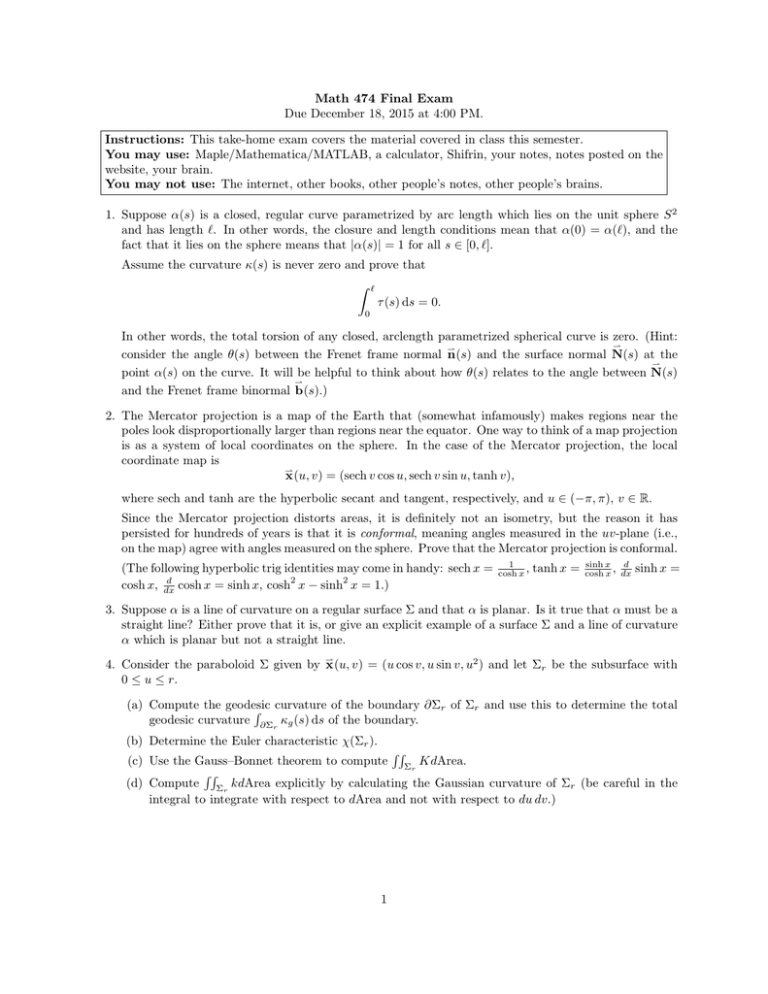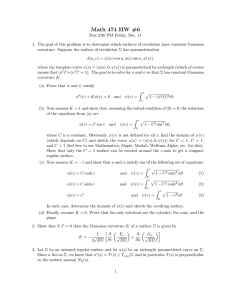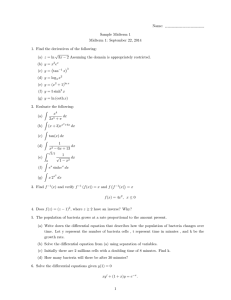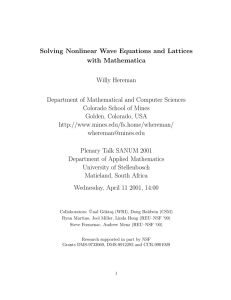Math 474 Final Exam Due December 18, 2015 at 4:00 PM.
advertisement

Math 474 Final Exam Due December 18, 2015 at 4:00 PM. Instructions: This take-home exam covers the material covered in class this semester. You may use: Maple/Mathematica/MATLAB, a calculator, Shifrin, your notes, notes posted on the website, your brain. You may not use: The internet, other books, other people’s notes, other people’s brains. 1. Suppose α(s) is a closed, regular curve parametrized by arc length which lies on the unit sphere S 2 and has length `. In other words, the closure and length conditions mean that α(0) = α(`), and the fact that it lies on the sphere means that |α(s)| = 1 for all s ∈ [0, `]. Assume the curvature κ(s) is never zero and prove that Z ` τ (s) ds = 0. 0 In other words, the total torsion of any closed, arclength parametrized spherical curve is zero. (Hint: * * consider the angle θ(s) between the Frenet frame normal n(s) and the surface normal N(s) at the * point α(s) on the curve. It will be helpful to think about how θ(s) relates to the angle between N(s) * and the Frenet frame binormal b(s).) 2. The Mercator projection is a map of the Earth that (somewhat infamously) makes regions near the poles look disproportionally larger than regions near the equator. One way to think of a map projection is as a system of local coordinates on the sphere. In the case of the Mercator projection, the local coordinate map is * x(u, v) = (sech v cos u, sech v sin u, tanh v), where sech and tanh are the hyperbolic secant and tangent, respectively, and u ∈ (−π, π), v ∈ R. Since the Mercator projection distorts areas, it is definitely not an isometry, but the reason it has persisted for hundreds of years is that it is conformal, meaning angles measured in the uv-plane (i.e., on the map) agree with angles measured on the sphere. Prove that the Mercator projection is conformal. (The following hyperbolic trig identities may come in handy: sech x = d cosh x, dx cosh x = sinh x, cosh2 x − sinh2 x = 1.) 1 cosh x , tanh x = sinh x d cosh x , dx sinh x = 3. Suppose α is a line of curvature on a regular surface Σ and that α is planar. Is it true that α must be a straight line? Either prove that it is, or give an explicit example of a surface Σ and a line of curvature α which is planar but not a straight line. * 4. Consider the paraboloid Σ given by x(u, v) = (u cos v, u sin v, u2 ) and let Σr be the subsurface with 0 ≤ u ≤ r. (a) Compute the geodesic R curvature of the boundary ∂Σr of Σr and use this to determine the total geodesic curvature ∂Σr κg (s) ds of the boundary. (b) Determine the Euler characteristic χ(Σr ). RR (c) Use the Gauss–Bonnet theorem to compute Σr KdArea. RR (d) Compute Σr kdArea explicitly by calculating the Gaussian curvature of Σr (be careful in the integral to integrate with respect to dArea and not with respect to du dv.) 1







